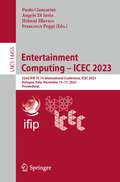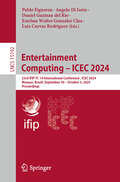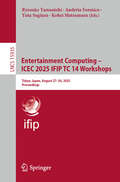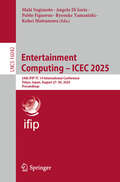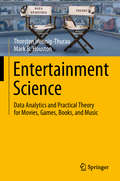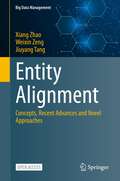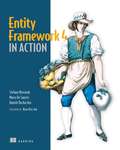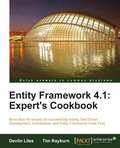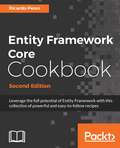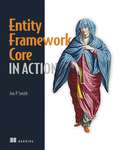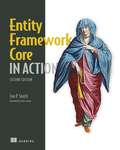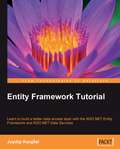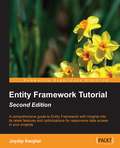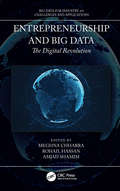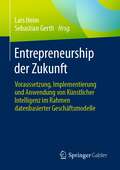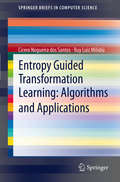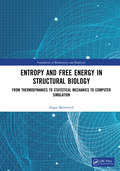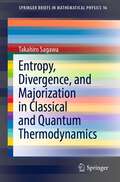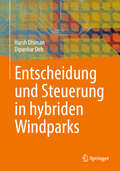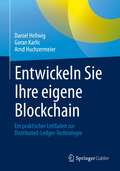- Table View
- List View
Entertainment Computing – ICEC 2023: 22nd IFIP TC 14 International Conference, ICEC 2023, Bologna, Italy, November 15–17, 2023, Proceedings (Lecture Notes in Computer Science #14455)
by Francesco Poggi Angelo Di Iorio Paolo Ciancarini Helmut HlavacsThis book constitutes the refereed proceedings of the 22nd IFIP TC 14 International Conference on Entertainment Computing, ICEC 2023, which was held in Bologna, Italy, during November 15–17, 2023. The 13 full papers and 5 short papers presented in this book were carefully reviewed and selected from 85 submissions. They cover a large range of topics in the following thematic areas: Game Experience; Player Engagement and Analysis; Serious Gameplay; Entertainment Methods and Tools; Extended Reality; Game Design; Interactive Entertainment; Student Game Competition; Workshops and Tutorials; and Aesthetics and Empowerment. .
Entertainment Computing – ICEC 2024: 23rd IFIP TC 14 International Conference, ICEC 2024, Manaus, Brazil, September 30 – October 3, 2024, Proceedings (Lecture Notes in Computer Science #15192)
by Angelo Di Iorio Pablo Figueroa Daniel Guzman del Rio Esteban Walter Gonzalez Clua Luis Cuevas RodriguezThis book constitutes the refereed proceedings of the 23rd International Conference on Entertainment Computing (IFIP-ICEC 2024) which was held in Manaus, Brazil, during September 30 – October 3, 2024. The 13 full papers, 8 short papers and 17 papers of other types presented in this volume were carefully reviewed and selected from 60 submissions. The works collected in this volume discuss latest findings in the areas of Game Experience, Player Engagement and Analysis, Serious Gameplay, Entertainment Methods and Tools, Extended Reality and Game Design.
Entertainment Computing – ICEC 2025 IFIP TC 14 Workshops: Tokyo, Japan, August 27–30, 2025, Proceedings (Lecture Notes in Computer Science #15935)
by Ryosuke Yamanishi Kohei Matsumura Andréia Formico Yuta SugiuraThis book constitutes the refereed proceedings of the workshops held in conjunction with the 24th IFIP International Conference on Entertainment Computing, ICEC 2025, which took place in Tokyo, Japan, during August 27–30, 2025. The 7 full papers included in this book were carefully reviewed and selected from 23 submissions. The proceedings also contain 5 workshop descriptions. The papers deal with new ideas, ongoing work, and interdisciplinary collaboration in entertainment computing.
Entertainment Computing – ICEC 2025: 24th IFIP TC 14 International Conference, Tokyo, Japan, August 27–30, 2025, Proceedings (Lecture Notes in Computer Science #16042)
by Angelo Di Iorio Pablo Figueroa Maki Sugimoto Ryosuke Yamanishi Kohei MatsumuraThis book constitutes the refereed proceedings of the 24th International Conference on Entertainment Computing, ICEC 2025, held in Tokyo, Japan, during August 27–30, 2025. The 28 full papers and 17 short papers included in this book were carefully reviewed and selected from 109 submissions. They were organized in topical sections as follows: Full Conference Papers; Work in Progress; Interactive Entertainment Showcase; and Student Competition..
Entertainment Science: Data Analytics And Practical Theory For Movies, Games, Books, And Music
by Thorsten Hennig-Thurau Mark B. HoustonThe entertainment industry has long been dominated by legendary screenwriter William Goldman’s “Nobody-Knows-Anything” mantra, which argues that success is the result of managerial intuition and instinct. This book builds the case that combining such intuition with data analytics and rigorous scholarly knowledge provides a source of sustainable competitive advantage – the same recipe for success that is behind the rise of firms such as Netflix and Spotify, but has also fueled Disney’s recent success. Unlocking a large repertoire of scientific studies by business scholars and entertainment economists, the authors identify essential factors, mechanisms, and methods that help a new entertainment product succeed. The book thus offers a timely alternative to “Nobody-Knows” decision-making in the digital era: while coupling a good idea with smart data analytics and entertainment theory cannot guarantee a hit, it systematically and substantially increases the probability of success in the entertainment industry. Entertainment Science is poised to inspire fresh new thinking among managers, students of entertainment, and scholars alike.Thorsten Hennig-Thurau and Mark B. Houston – two of our finest scholars in the area of entertainment marketing – have produced a definitive research-based compendium that cuts across various branches of the arts to explain the phenomena that provide consumption experiences to capture the hearts and minds of audiences.Morris B. Holbrook, W. T. Dillard Professor Emeritus of Marketing, Columbia UniversityEntertainment Science is a must-read for everyone working in the entertainment industry today, where the impact of digital and the use of big data can’t be ignored anymore. Hennig-Thurau and Houston are the scientific frontrunners of knowledge that the industry urgently needs.Michael Kölmel, media entrepreneur and Honorary Professor of Media Economics at University of LeipzigEntertainment Science’s winning combination of creativity, theory, and data analytics offers managers in the creative industries and beyond a novel, compelling, and comprehensive approach to support their decision-making. This ground-breaking book marks the dawn of a new Golden Age of fruitful conversation between entertainment scholars, managers, and artists.Allègre Hadida, Associate Professor in Strategy, University of Cambridge
Entity Alignment: Concepts, Recent Advances and Novel Approaches (Big Data Management)
by Xiang Zhao Weixin Zeng Jiuyang TangThis open access book systematically investigates the topic of entity alignment, which aims to detect equivalent entities that are located in different knowledge graphs. Entity alignment represents an essential step in enhancing the quality of knowledge graphs, and hence is of significance to downstream applications, e.g., question answering and recommender systems. Recent years have witnessed a rapid increase in the number of entity alignment frameworks, while the relationships among them remain unclear. This book aims to fill that gap by elaborating the concept and categorization of entity alignment, reviewing recent advances in entity alignment approaches, and introducing novel scenarios and corresponding solutions.Specifically, the book includes comprehensive evaluations and detailed analyses of state-of-the-art entity alignment approaches and strives to provide a clear picture of the strengths and weaknesses of the currently available solutions, so as to inspire follow-up research. In addition, it identifies novel entity alignment scenarios and explores the issues of large-scale data, long-tail knowledge, scarce supervision signals, lack of labelled data, and multimodal knowledge, offering potential directions for future research. The book offers a valuable reference guide for junior researchers, covering the latest advances in entity alignment, and a valuable asset for senior researchers, sharing novel entity alignment scenarios and their solutions. Accordingly, it will appeal to a broad audience in the fields of knowledge bases, database management, artificial intelligence and big data.
Entity Authentication and Personal Privacy in Future Cellular Systems
by Geir M. KoienThere are now (Q1 2009) more than 4 billion cellular subscribers in the world and this number is constantly growing. With this in mind it should be clear that use of mobile communication has already become both pervasive and ubiquitous. It has become a global commodity really. Entity Authentication and Personal Privacy in Future Cellular Systems aims at explaining and examining access security as it is found in mobile/cellular systems. A thorough investigation of how access security and personal privacy is handled in the 3GPP system is conducted. This includes both the 2G systems GSM/GPRS and the 3G system UMTS. The emerging fourth generation LTE architecture is also examined. The first part of the book deals exclusively with presenting access security as found in the 3GPP system. Particular attention is given to the authentication and key agreement procedures. The 3GPP systems have evolved and the access security architecture in LTE is substantially more advanced and mature than what you would find in GSM/GPRS, but even the LTE security architecture has its limitations. In part two of the book we go on to examine what is missing from the current cellular access security architectures. Some of the shortcomings found in GSM/GPRS and later UMTS have been partially addressed in LTE, but the burden of backwards compatibility has meant that many issues could not easily be resolved. Free from those restrictions, we shall see that one can provide substantially improved subscriber privacy and enhanced entity authentication, while also avoiding the delegated authentication control that all 3GPP systems have.The design of authentication protocols is discussed in depth, and this would also include looking into the role of formal verification in the design of security protocols.
Entity Framework 4 in Action
by Stefano Mostarda Marco De Sanctis Daniele BochicchioSummaryEntity Framework 4 in Action is an example-rich tutorial for .NET developers with full coverage of EF 4 features. The book begins with a review of the core ideas behind the ORM model and shows through detailed examples and larger case studies how Entity Framework offers a smooth transition from a traditional ADO.NET approach.About the TechnologyEntity Framework builds on the ADO.NET persistence model and the language features of LINQ to create a powerful persistence mechanism that bridges the gap between relational databases and object-oriented languages.About the BookEntity Framework 4 in Action is an example-rich tutorial that helps .NET developers learn and master the subject. It begins by explaining object/relational mapping and then shows how you can easily transition to EF from ADO.NET. Through numerous focused examples and two larger case studies, the book unfolds the EF story in a clear, easy-to-follow style. Infrastructure and inner workings of EF are discussed when you need them to understand a particular feature.This book is written for .NET developers. Knowledge of ADO.NET is helpful but not required. Purchase of the print book comes with an offer of a free PDF, ePub, and Kindle eBook from Manning. Also available is all code from the book. What's InsideFull coverage of EF 4 featuresLayer separation, Data Layer, and Domain ModelBest practicesTable of ContentsPART 1 REDEFINING YOUR DATA-ACCESS STRATEGYData access reloaded: Entity FrameworkGetting started with Entity FrameworkPART 2 GETTING STARTED WITH ENTITY FRAMEWORKQuerying the object model: the basicsQuerying with LINQ to EntitiesDomain model mappingUnderstanding the entity lifecyclePersisting objects into the databaseHandling concurrency and transactionsPART 3 MASTERING ENTITY FRAMEWORKAn alternative way of querying: Entity SQLWorking with stored proceduresWorking with functions and viewsExploring EDM metadataCustomizing code and the designer
Entity Framework 4.1: Expert's Cookbook
by Devlin Liles Tim RayburnThis book takes a step-by-step problem solving approach that leads you through a problem and explains each step in detail to accomplish the goal. This books gives you concrete code examples as well as detailed information on the decisions involved. This book is for intermediate to advanced .NET developers who have used LINQ to SQL or Entity Framework in some form but want to have more control over the implementation.
Entity Framework 6 Recipes
by Brian Driscoll Nitin Gupta Rob Vettor Zeeshan Hirani Larry TennyEntity Framework6 Recipes provides an exhaustive collection of ready-to-use code solutions for Entity Framework, Microsoft'smodel-centric, data-access platform for the . NET Framework and ASP. NET development. With this book, you will learn the core concepts of Entity Framework through a broad range of clear and concise solutions to everyday data access tasks. Armed with this experience, you will be ready to dive deep into Entity Framework, experiment with new approaches, and develop ways to solve even the most difficult data access challenges. If you are a developer who likes to learn by example, then this is the right book for you. Gives ready-to-use, real-world recipes to help you with everyday tasks Places strong focus on DbContext and the Code First approach Covers new features such as Asynch Query and Save, Codebased Configuration, Connection Resiliency, Dependency Resolution, and much more "
Entity Framework Core Cookbook - Second Edition
by Ricardo PeresLeverage the full potential of Entity Framework with this collection of powerful and easy-to-follow recipes About This Book * Learn how to use the new features of Entity Framework Core 1 * Improve your queries by leveraging some of the advanced features * Avoid common pitfalls * Make the best of your .NET APIs by integrating with Entity Framework Who This Book Is For This book is for .NET developers who work with relational databases on a daily basis and understand the basics of Entity Framework, but now want to use it in a more efficient manner. You are expected to have some prior knowledge of Entity Framework. What You Will Learn * Master the technique of using sequence key generators * Validate groups of entities that are to be saved / updated * Improve MVC applications that cover applications developed using ASP.NET MVC Core 1 * Retrieve database information (table, column names, and so on) for entities * Discover optimistic concurrency control and pessimistic concurrency control. * Implement Multilatency on the data side of things. * Enhance the performance and/or scalability of Entity Framework Core * Explore and overcome the pitfalls of Entity Framework Core In Detail Entity Framework is a highly recommended Object Relation Mapping tool used to build complex systems. In order to survive in this growing market, the knowledge of a framework that helps provide easy access to databases, that is, Entity Framework has become a necessity. This book will provide .NET developers with this knowledge and guide them through working efficiently with data using Entity Framework Core. You will start off by learning how to efficiently use Entity Framework in practical situations. You will gain a deep understanding of mapping properties and find out how to handle validation in Entity Framework. The book will then explain how to work with transactions and stored procedures along with improving Entity Framework using query libraries. Moving on, you will learn to improve complex query scenarios and implement transaction and concurrency control. You will then be taught to improve and develop Entity Framework in complex business scenarios. With the concluding chapter on performance and scalability, this book will get you ready to use Entity Framework proficiently. Style and approach Filled with rich code-based examples, this book takes a recipe-based approach that will teach .NET developers to improve their understanding of Entity Framework and help them effortlessly apply this knowledge in everyday situations.
Entity Framework Core in Action
by Jon SmithSummaryEntity Framework Core in Action teaches you how to access and update relational data from .NET applications. Following the crystal-clear explanations, real-world examples, and around 100 diagrams, you'll discover time-saving patterns and best practices for security, performance tuning, and unit testing.Purchase of the print book includes a free eBook in PDF, Kindle, and ePub formats from Manning Publications.About the TechnologyThere's a mismatch in the way OO programs and relational databases represent data. Entity Framework is an object-relational mapper (ORM) that bridges this gap, making it radically easier to query and write to databases from a .NET application. EF creates a data model that matches the structure of your OO code so you can query and write to your database using standard LINQ commands. It will even automatically generate the model from your database schema.About the BookUsing crystal-clear explanations, real-world examples, and around 100 diagrams, Entity Framework Core in Action teaches you how to access and update relational data from .NET applications. You'l start with a clear breakdown of Entity Framework, long with the mental model behind ORM. Then you'll discover time-saving patterns and best practices for security, performance tuning, and even unit testing. As you go, you'll address common data access challenges and learn how to handle them with Entity Framework.What's InsideQuerying a relational database with LINQUsing EF Core in business logicIntegrating EF with existing C# applicationsApplying domain-driven design to EF CoreGetting the best performance out of EF CoreCovers EF Core 2.0 and 2.1About the ReaderFor .NET developers with some awareness of how relational databases work.About the AuthorJon P Smith is a full-stack developer with special focus on .NET Core and Azure.Table of ContentsPart 1 - Getting startedIntroduction to Entity FrameworkCoreQuerying the database Changing the database content Using EF Core in business logic Using EF Core in ASP.NET Core web applications Part 2 - Entity Framework in depthConfiguring nonrelational properties Configuring relationships Configuring advanced features and handling concurrency conflicts Going deeper into the DbContext Part 3 - Using Entity Framework Core in real-world applicationsUseful software patterns for EF Core applications Handling database migrations EF Core performance tuning A worked example of performance tuning Different database types and EF Core services Unit testing EF Core applicationsAppendix A - A brief introduction to LINQ Appendix B - Early information on EF Core version 2.1
Entity Framework Core in Action, Second Edition
by Jon P SmithEntity Framework Core in Action, Second Edition teaches you to write flawless database interactions for .NET applications. Summary Entity Framework Core in Action, Second Edition is an in-depth guide to reading and writing databases with EF Core. Revised from the bestselling original edition, it&’s filled with over 100 diagrams, code snippets, and examples—including building and scaling your own bookselling web application. Learn from author Jon Smith&’s extensive experience working with EF Core in production, as you discover time-saving patterns and best practices for security, performance tuning, and unit testing. All of the book&’s code is available on GitHub. Purchase of the print book includes a free eBook in PDF, Kindle, and ePub formats from Manning Publications. About the technology Entity Framework radically simplifies data access in .NET applications. This easy-to-use object-relational mapper (ORM) lets you write database code in pure C#. It automatically maps classes to database tables and enables queries with standard LINQ commands. It even generates SQL, so you don&’t have to! About the book Entity Framework Core in Action, Second Edition teaches you to write flawless database interactions for .NET applications. Following relevant examples from author Jon Smith&’s extensive experience, you&’ll progress quickly from EF basics to advanced techniques. In addition to the latest EF features, this book addresses performance, security, refactoring, and unit testing. This updated edition also contains new material on NoSQL databases. What's inside Configure EF to define every table and column Update your schema as your app grows Integrating EF with existing C# application Write and test business logic for database access Applying a Domain-Driven Design to EF Core Getting the best performance out of EF Core About the reader For .NET developers familiar with relational databases. About the author Jon P. Smith is a freelance software developer and architect with a special focus on .NET and Azure. Table of Contents PART 1 1 Introduction to Entity Framework Core 2 Querying the database 3 Changing the database content 4 Using EF Core in business logic 5 Using EF Core in ASP.NET Core web applications 6 Tips and techniques for reading and writing with EF Core PART 2 7 Configuring nonrelational properties 8 Configuring relationships 9 Handling database migrations 10 Configuring advanced features and handling concurrency conflicts 11 Going deeper into the DbContext PART 3 12 Using entity events to solve business problems 13 Domain-Driven Design and other architectural approaches 14 EF Core performance tuning 15 Master class on performance-tuning database queries 16 Cosmos DB, CQRS, and other database types 17 Unit testing EF Core applications
Entity Framework Tutorial
by Joydip KanjilalThis book is written as a tutorial, leading you through examples to illuminate the main theory and get you working with the Entity Framework as quickly as possible. This book is for C# developers who want an easier way to create their data access layer. You will need to be comfortable with ADO.NET, but you don't need to know anything about the Entity Framework. Along the way we will create some ASP.NET applications, so being familiar with this will also help.
Entity Framework Tutorial - Second Edition
by Joydip KanjilalA comprehensive guide to the Entity Framework with insight into its latest features and optimizations for responsive data access in your projects About This Book * Create Entity data models from your database and use them in your applications * Learn about the Entity Client data provider and write statements in Entity SQL to perform CRUD operations * Explore ADO.NET Data Services and how they work with the Entity Framework Who This Book Is For If you are a C# developer who wants to learn a new way of querying data and utilizing it in applications efficiently for data binding or other operations, then this book is for you. Basic knowledge of ADO.NET is assumed. What You Will Learn * Explore the features of the ADO.NET Entity Framework * Understand the concepts of entities and their relationships * Create an Entity Data Model using the ADO.NET Entity Data Model Designer and the EdmGen tool * Extend existing Entity Types to create your own Entity Types * Write programs against the Entity Data Model to perform CRUD operations * Discover ADO.NET Data Services and learn how they can be used with the Entity Framework * Familiarize yourself with WCF Data Services (formerly ADO.NET Data Services) * Apply Code First, Model First and Database First approaches In Detail The ADO.NET Entity Framework from Microsoft is a new ADO.NET development framework that provides a level of abstraction for data access strategies and solves the impedance mismatch issues that exist between different data models. This book explores Microsoft's Entity Framework and explains how it can used to build enterprise level applications. It will also teach you how you can work with RESTful Services and Google's Protocol Buffers with Entity Framework and WCF. You will explore how to use Entity Framework with ASP.NET Web API and also how to consume the data exposed by Entity Framework from client applications of varying types, i.e., ASP.NET MVC, WPF and Silverlight. You will familiarize yourself with the new features and improvements introduced in Entity Framework including enhanced POCO support, template-based code generation, tooling consolidation and connection resiliency. By the end of the book, you will be able to successfully extend the new functionalities of Entity framework into your project. Style and approach This book is a step-by-step tutorial providing hands-on code examples with detailed explanations. The book aims to explain the concepts of the Entity Framework and illustrate how you can use these in applications with a tutorial based approach.
Entrepreneurship and Big Data: The Digital Revolution (Big Data for Industry 4.0)
by Chhabra Meghna Hassan Rohail Shamim AmjadThe digital age has transformed business opportunities and strategies in a resolutely practical and data-driven project universe. This book is a comprehensive and analytical source on entrepreneurship and Big Data that prospective entrepreneurs must know before embarking upon an entrepreneurial journey in this present age of digital transformation. This book provides an overview of the various aspects of entrepreneurship, function, and contemporary forms. It covers a real-world understanding of how the entrepreneurial world works and the required new analytics thinking and computational skills. It also encompasses the essential elements needed when starting an entrepreneurial journey and offers inspirational case studies from key industry leaders. Ideal reading for aspiring entrepreneurs, Entrepreneurship and Big Data: The Digital Revolution is also useful to students, academicians, researchers, and practitioners.
Entrepreneurship der Zukunft: Voraussetzung, Implementierung und Anwendung von Künstlicher Intelligenz im Rahmen datenbasierter Geschäftsmodelle
by Sebastian Gerth Lars HeimDieses Buch behandelt die Rolle von Künstlicher Intelligenz (KI) im Kontext der fortlaufenden Digitalisierung und Automatisierung in Unternehmen, um Wertschöpfung zu optimieren, neue Geschäftsmodelle zu entwickeln oder bestehende zu transformieren. Untersucht werden Voraussetzungen, Implementierung und Anwendung von KI in datenbasierten Geschäftsmodellen und dabei sowohl Chancen als auch Risiken beleuchtet.Der erste Buchabschnitt konzentriert sich auf die erforderlichen Bedingungen für den erfolgreichen Einsatz von KI. Hierzu zählen die Erfassung und Verarbeitung von Daten, der Aufbau einer robusten IT-Infrastruktur und die Personalschulung. Im zweiten Abschnitt wird die Implementierung von KI diskutiert. Besonderer Fokus liegt dabei auf dem Aufbau und Training von KI-Systemen und deren Integration in bestehende Geschäftsprozesse. Verschiedene Ansätze der KI, wie Machine Learning und Deep Learning, werden erläutert und ihre Anwendungsmöglichkeiten aufgezeigt. Der dritte Abschnitt widmet sich der praktischen Anwendung von KI in verschiedenen Branchen und Geschäftsmodellen. So werden etwa Beispiele aus der Produktion, dem Handel und der Dienstleistungsbranche vorgestellt, um den Einsatz von KI zur Automatisierung von Prozessen, Optimierung von Entscheidungen und Verbesserung von Prognosen zu demonstrieren.Insgesamt bietet das Buch eine umfassende Perspektive auf das Thema KI und liefert in 17 Kapiteln wertvolle Anregungen für Unternehmen, um ihre Zukunftsfähigkeit mit KI zu sichern und von den Möglichkeiten zu profitieren. Die Beiträge von führenden Expert:innen aus unterschiedlichen Disziplinen, mit verschiedenen theoretischen Ansätzen, methodischen Zugängen und empirischen Befunden beleuchten und diskutieren das Thema sehr anschaulich.
Entrepreneurship und Unternehmensgründung in Deutschland: Fallstudien zu Gründerpersönlichkeiten
by Annette Hoxtell Volker HasewinkelDieses Lehrbuch enthält Fallstudien von GründerInnen aus ganz Deutschland, aus verschiedenen Branchen mit unterschiedlichen Lebensläufen und Hintergründen. Sie gründen allein oder im Team, wollen reich werden oder die Welt verbessern und sind finanziell mehr oder weniger erfolgreich. Was sie verbindet, sind Risikobereitschaft, Engagement und Verantwortung: Sie sehen und ergreifen Chancen und nehmen dabei Risiken in Kauf, sie engagieren sich für ihre Idee und ihre KundInnen und sie übernehmen Verantwortung für das eigene Tun, die MitarbeiterInnen und das eigene Unternehmen. Die vorgestellten Persönlichkeiten können Vorbilder für künftige GründerInnen sein, sie sind ein wesentlicher Teil der Wirtschaft und der Gesellschaft.Die AutorInnen der Fallstudien gehen der Frage nach, weshalb die jeweilige Person ihr Unternehmen gründet. Sie beleuchten Erfolge und Schwierigkeiten bis hin zum Scheitern und prüfen, ob es größere Zusammenhänge gibt, die eine Gründung beeinflussen. Alle Fallstudien verbindet ein gemeinsamer Rahmen: Nach den GründerInnen werden ihre Unternehmen vorgestellt und die Kapitel mit didaktischen Fragen geschlossen. Das Alter bei der Gründung – es reicht von 23 bis 73 Jahren – gliedert den Band. Die Fallstudien eignen sich sowohl für den Einsatz in Lehrveranstaltungen als auch als inspirierende Lektüre für Menschen, die abwägen, ob und unter welchen Bedingungen eine Gründung für sie in Betracht kommt. Selbständige können durch die Beschäftigung mit den Fallstudien ihre eigene Tätigkeit reflektieren und Anregungen erhalten.Die 2. Auflage wurde gegenüber der ersten Auflage von 11 auf 23 Fallstudien erweitert. Die Einleitung und viele Fallstudien aus der ersten Auflage wurden aktualisiert und überarbeitet. Ein grundlegendes Kapitel zu Charakteristika von EntrepreneurInnen und GründerInnen und Typen von Gründungen ist neu dazugekommen.
Entropy Guided Transformation Learning: Algorithms and Applications
by Cícero Nogueira Santos Ruy Luiz MilidiúEntropy Guided Transformation Learning: Algorithms and Applications (ETL) presents a machine learning algorithm for classification tasks. ETL generalizes Transformation Based Learning (TBL) by solving the TBL bottleneck: the construction of good template sets. ETL automatically generates templates using Decision Tree decomposition. The authors describe ETL Committee, an ensemble method that uses ETL as the base learner. Experimental results show that ETL Committee improves the effectiveness of ETL classifiers. The application of ETL is presented to four Natural Language Processing (NLP) tasks: part-of-speech tagging, phrase chunking, named entity recognition and semantic role labeling. Extensive experimental results demonstrate that ETL is an effective way to learn accurate transformation rules, and shows better results than TBL with handcrafted templates for the four tasks. By avoiding the use of handcrafted templates, ETL enables the use of transformation rules to a greater range of tasks. Suitable for both advanced undergraduate and graduate courses, Entropy Guided Transformation Learning: Algorithms and Applications provides a comprehensive introduction to ETL and its NLP applications.
Entropy Randomization in Machine Learning
by Yuri S. Popkov Alexey Yu. Popkov Yuri A. DubnovEntropy Randomization in Machine Learning presents a new approach to machine learning—entropy randomization—to obtain optimal solutions under uncertainty (uncertain data and models of the objects under study). Randomized machine-learning procedures involve models with random parameters and maximum entropy estimates of the probability density functions of the model parameters under balance conditions with measured data. Optimality conditions are derived in the form of nonlinear equations with integral components. A new numerical random search method is developed for solving these equations in a probabilistic sense. Along with the theoretical foundations of randomized machine learning, Entropy Randomization in Machine Learning considers several applications to binary classification, modelling the dynamics of the Earth’s population, predicting seasonal electric load fluctuations of power supply systems, and forecasting the thermokarst lakes area in Western Siberia. Features • A systematic presentation of the randomized machine-learning problem: from data processing, through structuring randomized models and algorithmic procedure, to the solution of applications-relevant problems in different fields • Provides new numerical methods for random global optimization and computation of multidimensional integrals • A universal algorithm for randomized machine learning This book will appeal to undergraduates and postgraduates specializing in artificial intelligence and machine learning, researchers and engineers involved in the development of applied machine learning systems, and researchers of forecasting problems in various fields.
Entropy and Free Energy in Structural Biology: From Thermodynamics to Statistical Mechanics to Computer Simulation (Foundations of Biochemistry and Biophysics)
by Hagai MeirovitchNuclear Structure Physics connects to some of our fundamental questions about the creation of the universe and its basic constituents. At the same time, precise knowledge on the subject has led to the development of many important tools for humankind such as proton therapy and radioactive dating, among others. This book has chapters on some of the crucial and trending research topics in nuclear structure, including the nuclei lying on the extremes of spin, isospin and mass. A better theoretical understanding of these topics is important beyond the confines of the nuclear structure community. Additionally, the book will showcase the applicability and success of the different nuclear effective interaction parameters near the drip line, where hints for level reordering have already been seen, and where one can test the isospin-dependence of the interaction. The book offers comprehensive coverage of the most essential topics, including: • Nuclear Structure of Nuclei at or Near Drip-Lines • Synthesis challenges and properties of Superheavy nuclei • Nuclear Structure and Nuclear models - Ab-initio calculations, cluster models, Shell-model/DSM, RMF, Skyrme • Shell Closure, Magicity and other novel features of nuclei at extremes • Structure of Toroidal, Bubble Nuclei, halo and other exotic nuclei These topics are not only very interesting from a theoretical nuclear physics perspective but are also quite complimentary for ongoing nuclear physics experimental programs worldwide. The book chapters, written by experienced and well-known researchers/experts, will be helpful for master students, graduate students and researchers and serve as a standard and up-to-date research reference book on the topics covered.
Entropy, Divergence, and Majorization in Classical and Quantum Thermodynamics (SpringerBriefs in Mathematical Physics #16)
by Takahiro SagawaRich information-theoretic structure in out-of-equilibrium thermodynamics exists in both the classical and quantum regimes, leading to the fruitful interplay among statistical physics, quantum information theory, and mathematical theories such as matrix analysis and asymptotic probability theory. The main purpose of this book is to clarify how information theory works behind thermodynamics and to shed modern light on it.The book focuses on both purely information-theoretic concepts and their physical implications. From the mathematical point of view, rigorous proofs of fundamental properties of entropies, divergences, and majorization are presented in a self-contained manner. From the physics perspective, modern formulations of thermodynamics are discussed, with a focus on stochastic thermodynamics and resource theory of thermodynamics. In particular, resource theory is a recently developed field as a branch of quantum information theory to quantify “useful resources” and has an intrinsic connection to various fundamental ideas of mathematics and information theory. This book serves as a concise introduction to important ingredients of the information-theoretic formulation of thermodynamics.
Entscheidung und Steuerung in hybriden Windparks
by Dipankar Deb Harsh DhimanDieses Buch fokussiert auf zwei zentrale Aspekte im Betrieb von Windparks: Entscheidungen und Steuerung. Im ersten Teil werden Entscheidungsprozesse erläutert, bei denen der Betrieb von Hybrid-Windparks von der Auswahl optimaler Alternativen zur Einspeisung von Windenergie ins Netz abhängt. Präzise Windvorhersagen sind entscheidend, um Fehler auszugleichen und mittels eines Batteriespeichersystems Reservekapazitäten ins Netz einzuspeisen. MCDM-Methoden und ein unscharfer Ansatz werden verwendet, um die besten Optionen zu bewerten. Fallstudien aus US-amerikanischen Windparks bieten numerische Lösungen. Im zweiten Teil liegt der Fokus auf der Steuerung, insbesondere der Yaw-Winkel-Steuerung zur Leistungsoptimierung der Turbinen. Eine Transferfunktions-basierte Methode zur Steuerung des Wirbelzentrums wird vorgestellt, begleitet von lidar-basierten Simulationen und adaptiven Steuerungsstrategien für verschiedene Windparklayouts. Die Auswirkungen des Yaw-Winkels auf die Betriebskosten des Batteriespeichersystems werden analysiert, unterstützt durch Fallstudien aus den USA und Dänemark.
Entscheidungsorientiertes Life Cycle Sustainability Assessment: Ein integrativer Ansatz zur Bewertung und Gestaltung nachhaltiger Produktionssysteme (Produktion und Logistik)
by Jan-Linus PopienJan-Linus Popien entwickelt mit dem entscheidungsorientierten Life Cycle Sustainability Assessment (eoLCSA) einen neuen Ansatz zur Bewertung und Gestaltung von Produktionssystemen entlang der drei Nachhaltigkeitsdimensionen. Aufbauend auf Rechnungswesen und Life Cycle Management wird die ökonomische Wirkungsabschätzungsmethode DEALA samt Leitfaden entwickelt und in das eoLCSA integriert. Ziel ist eine transparente, anschlussfähige und standardnahe Entscheidungsunterstützung. Zur Anwendung dient die Batteriewertschöpfungskette. In einer Fallstudie wird sie umfassend hinsichtlich ihrer Auswirkungen analysiert. Zudem wird ein lineares Optimierungsmodell zur Gestaltung der Batteriewertschöpfungskette unter Berücksichtigung politischer Vorgaben wie der EU-Batterieverordnung und des Critical Raw Materials Act entwickelt. Die Ergebnisse zeigen, wie das eoLCSA als Bewertungs- und Entscheidungswerkzeug eingesetzt werden kann, um Zielkonflikte zwischen Nachhaltigkeitsdimensionen systematisch zu bewerten und Gestaltungsoptionen für Unternehmen und Politik abzuleiten.
Entwickeln Sie Ihre eigene Blockchain: Ein praktischer Leitfaden zur Distributed-Ledger-Technologie
by Arnd Huchzermeier Daniel Hellwig Goran KarlicDieses Buch bietet eine umfassende Einführung in die Blockchain- und Distributed-Ledger-Technologie. Es ist ein Leitfaden für Praktiker und enthält detaillierte Beispiele und Erklärungen, wie sich eine Blockchain von Grund auf neu aufbauen und betreiben lässt. Durch seinen konzeptionellen Hintergrund und praktische Übungen ermöglicht dieses Buch Studenten, Lehrern und Krypto-Enthusiasten, ihre erste Blockkette zu starten, wobei Vorkenntnisse der zugrunde liegenden Technologie vorausgesetzt werden.Wie baue ich eine Blockchain auf? Wie präge ich eine Kryptowährung? Wie schreibe ich einen Smart Contract? Wie starte ich ein Initial Coin Offering (ICO)? Dies sind einige der Fragen, die dieses Buch beantwortet. Ausgehend von den Anfängen und der Entwicklung früher Kryptowährungen werden die konzeptionellen Grundlagen für die Entwicklung sicherer Software beschrieben. Die Themen umfassen u. a. Konsens-Algorithmen, Mining und Dezentralisierung. „Dies ist ein einzigartiges Buch über die Blockchain-Technologie. Die Autoren haben die perfekte Balance zwischen Breite der Themen und Tiefe der technischen Diskussion gefunden. Aber das wahre Juwel ist die Sammlung sorgfältig kuratierter praktischer Übungen, die den Leser schon ab Kapitel 1 durch den Prozess des Aufbaus einer Blockchain führen.“ Volodymyr Babich, Professor für Betriebs- und Informationsmanagement, McDonough School of Business, Georgetown University„Eine ausgezeichnete Einführung in die DLT-Technologie für ein nicht-technisches Publikum. Das Buch ist vollgepackt mit Beispielen und Übungen, die das Erlernen der zugrunde liegenden Prozesse der Blockchain-Technologie für alle, vom Studenten bis zum Unternehmer, erheblich erleichtern.“ Serguei Netessine, Dhirubhai Ambani Professor für Innovation und Entrepreneurship, The Wharton School, University of Pennsylvania
